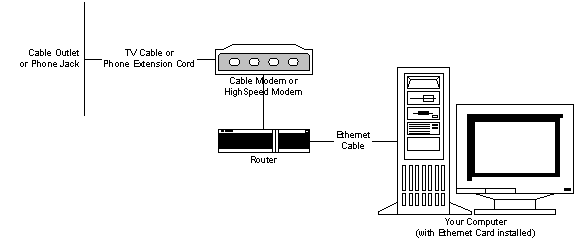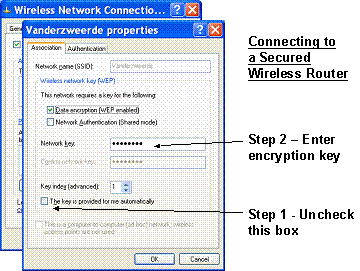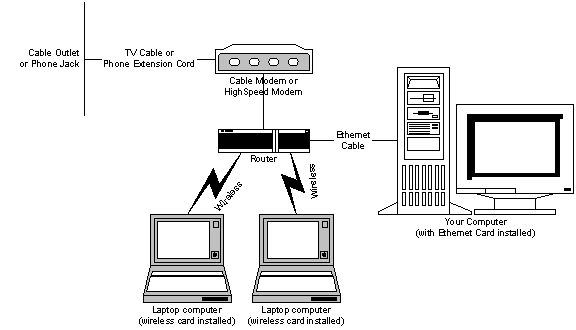Including: How to go Wireless
Written on July 3, 2005 by Robert & Karen Vanderzweerde
Appeared in Greenmaster Magazine
So you finally have a high-speed Internet connection at home.
Congratulations!
You may want to hook up more than one computer.
Or, you may want your computer to be wirelessly connected to the Internet.
It’s time to install a home network.
How to Get Started
First, you’ll need a high-speed or broadband connection (see the previous article).
You can run a network or a wireless link over dial-up but it would be excruciatingly slow.
Follow the directions of your Internet provider and connect your computer to the Internet
using either the cable connection or phone line.
Your connection should look like this:

Next, you’ll have to obtain and install a router.
Routers
What is a router? A router is a device that connects two networks
– in this case, the Internet and your home network.
It directs or “routes” information between devices on these networks.
For example, it connects your computer to your e-mail account.
Or, it can connect another computer in your home to a web server at the same time you’re reading your e-mail.
Most routers also have built-in firewalls.
A firewall prevents unauthorized people or computers on the Internet
from accessing your home computers without your permission.
It adds an extra layer of security.
However, don’t assume this will stop viruses and worms that get into your computer through e-mail or file sharing.
There are several companies that make routers.
Some of the more common brands available in Canada include Linksys, D-Link, and Netgear.
They are readily available from office supply stores (e.g. Business Depot)
or technology stores (e.g. Future Shop)
– look for networking devices in the computer or technology section of the store.
Your Internet service provider may also offer a “home networking” kit
which usually contains a router, cables, and easy to follow instructions.
There are several types of routers to choose from:
- Wired – where all the computers are connected with cables to the ports
on the back of the router – usually 4-port or 8-port versions are available
(connect up to 4 or 8 computers).
- Wireless – where the computers are connected wirelessly with the router
(this requires a wireless connector card to be installed in your computer) –
more on wireless connections later in this article.
- Mixed – a router with connections for both wired or wireless access.
Determine how you want to connect your computers and buy the router that’s best for you.
Wireless versions are slightly more expensive.
If you’re unsure, get a router with both wired and wireless capabilities.
For wired connections, don’t forget to buy extra Ethernet cables to connect each of your computers.
Installing and Configuring the Router
The router is usually easy to install by following the step-by-step instructions that come with it.
It will tell you which cable to unplug or plug-in next, when to turn equipment off or on,
and what default settings to change.
There are usually diagrams included and the instructions I’ve seen are very clear and concise.
Please follow the instructions in sequence and precisely to ensure a successful connection.
When you’re done, your set-up should look like this:

Only connect other computers to the router AFTER the main computer
is connected to the Internet using the router and everything is fully operational.
Connecting other computers should be as simple as using an Ethernet cable to connect the computer to the router.
Remember that each computer to be connected must have an Ethernet card installed or a built in Ethernet port.
Going Wireless
The freedom to connect to the Internet without any of those messy cables is alluring.
Going wireless in your home is as easy as buying a wireless router.
There are several wireless standards out there:
- Wireless-B – an older and slower connection
- Wireless G – a newer and faster connection
- Wireless G+ - the newest and fastest connection
Unless you’re going to need very fast connections,
a router with Wireless-G capabilities should be sufficient
(most of these routers are also able to run older Wireless-B connections at the same time).
Also consider getting a router with both wireless and some wired connections.
The installation of a wireless router is similar to a wired router
with one major exception – the security settings.
A wireless router sends out a signal that should be sufficient to reach every corner in your home.
However, the signal range will probably extend beyond your home and be detectable
by your neighbours or passers by (especially worrying if there is a coffee shop near your house
where people with wireless laptops could tap into your Internet connection).
While you can run your wireless network without security, it is not recommended.
As a minimum, use the WEP (Wired Equivalent Privacy) level of encryption security.
You will be asked to enter a keyword that will be used to create a 26-character encryption key.
Copy this encryption key down.
When a computer connects wireless to your router, it will “see” the connection but be unable to connect.
Open up the wireless connection (double click on the icon),
go into the configuration settings,
uncheck the box marked “The key is provided to me automatically”
and enter your encryption key into the boxes provided (see figure below).
Since only you know the encryption key, you control which computers can connect to your router.

Sample Home Network including Wireless Links
Here’s a sample of what you could accomplish.
In this home, there is a desktop computer connected using an inexpensive cable and Ethernet card,
and two mobile laptop computers utilizing their built-in wireless capabilities.
All the computers share one high-speed connection.

Good luck on your home networking or wireless project.
|







